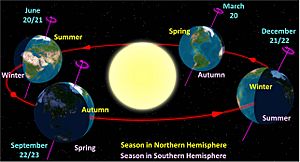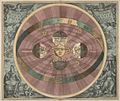Earth's orbit facts for kids
Every planet in our solar system travels around the Sun in a special path called an orbit. Earth's orbit is not a perfect circle; it's shaped more like a slightly squashed circle, which scientists call an ellipse. If you drew Earth's orbit as a perfect circle, the line would be thicker than the actual elliptical path!
It takes our Earth about 365 days to complete one full trip around the Sun. We call this period a year. This means the Earth is always moving very fast through space, at about 67,000 miles per hour!
The distance between Earth and the Sun changes throughout the year. When Earth is closest to the Sun, it's called perihelion. This happens when we are about 146 million kilometers (91 million miles) away. When Earth is farthest from the Sun, it's called aphelion, and we are about 152 million kilometers (94.5 million miles) away. Even at its closest, it still takes light from the Sun just over eight minutes to reach Earth!
The main reason we have different seasons on Earth is because our planet is tilted. Earth's axis (an imaginary line through its center) is tilted by about 23.4 degrees. This axial tilt, along with Earth's slightly elliptical orbit, causes the changes we see in our weather throughout the year.
Over very long periods, Earth's orbit changes slightly due to something called Milankovitch cycles. These slow changes are one of the natural causes of climate change on our planet.
Why Earth Has Seasons
Earth's axial tilt is super important for our seasons. Imagine the Earth spinning like a top. That top is tilted! Because of this tilt, the angle at which the Sun's rays hit different parts of Earth changes as our planet orbits the Sun.
When your part of the Earth is tilted towards the Sun, you get more direct sunlight. This means longer days and the Sun appears higher in the sky. More sunlight reaching the ground makes the temperatures warmer, bringing summer. When your part of the Earth is tilted away from the Sun, the opposite happens. You get less direct sunlight, shorter days, and the Sun appears lower. This leads to cooler temperatures and winter.
Near the very top and bottom of the Earth, above the Arctic Circle and below the Antarctic Circle, this effect is even more extreme. For part of the year, these areas are tilted so far away from the Sun that they experience no daylight at all! This is called a polar night. All these changes in how the Sun hits Earth because of its tilt create our different seasons.
Special Moments in Earth's Orbit
Astronomers mark the four seasons by special points in Earth's orbit: the solstices and the equinoxes.
- The solstices are the two times a year when Earth's tilt is at its maximum, either directly towards or directly away from the Sun.
- The equinoxes are the two times a year when Earth's tilted axis is exactly sideways to the Sun. At these points, day and night are almost equal in length all over the world.
These solstices and equinoxes divide the year into four roughly equal parts.
- In the Northern Hemisphere, the winter solstice is usually around December 21.
- The summer solstice is near June 21.
- The spring equinox is around March 20.
- The autumnal equinox is about September 23.
It's important to remember that the seasons are opposite in the Southern Hemisphere. So, when it's summer in the Northern Hemisphere, it's winter in the Southern Hemisphere!
Today, Earth reaches its closest point to the Sun (perihelion) around January 3. It reaches its farthest point from the Sun (aphelion) around July 4. When Earth is closer to the Sun, it actually receives about 6.9% more solar energy. Even though the Southern Hemisphere is tilted towards the Sun when Earth is closest, this extra energy doesn't make a huge difference to its climate. The tilt of the Earth's axis is much more important for the seasons than the changing distance to the Sun. Also, the Southern Hemisphere has more water, which absorbs a lot of that extra energy.
The Hill sphere is like Earth's personal space in terms of gravity. It's a huge area, about 1,500,000 kilometers (or 0.01 AU) wide, which is about four times the average distance to the Moon. Within this space, Earth's gravity is stronger than the Sun's. Any objects orbiting Earth, like our Moon or satellites, must stay within this "sphere of influence" or they might drift away because of the Sun's pull.
The diagram below shows how Earth's orbit looks, with the solstices and equinoxes marked. Remember, the shape of the orbit in the diagram is made more stretched out than it really is, just to help you see it better. Earth's actual orbit is much closer to a perfect circle.
Because of Earth's axial tilt, the Sun's most direct rays hit different parts of the Earth throughout the year.
- Around the June Solstice, the Sun's strongest rays hit 23.4 degrees north of the equator, at the Tropic of Cancer.
- Around the December Solstice, the Sun's strongest rays hit 23.4 degrees south of the equator, at the Tropic of Capricorn.
Images for kids
See also
 In Spanish: Traslación de la Tierra para niños
In Spanish: Traslación de la Tierra para niños





